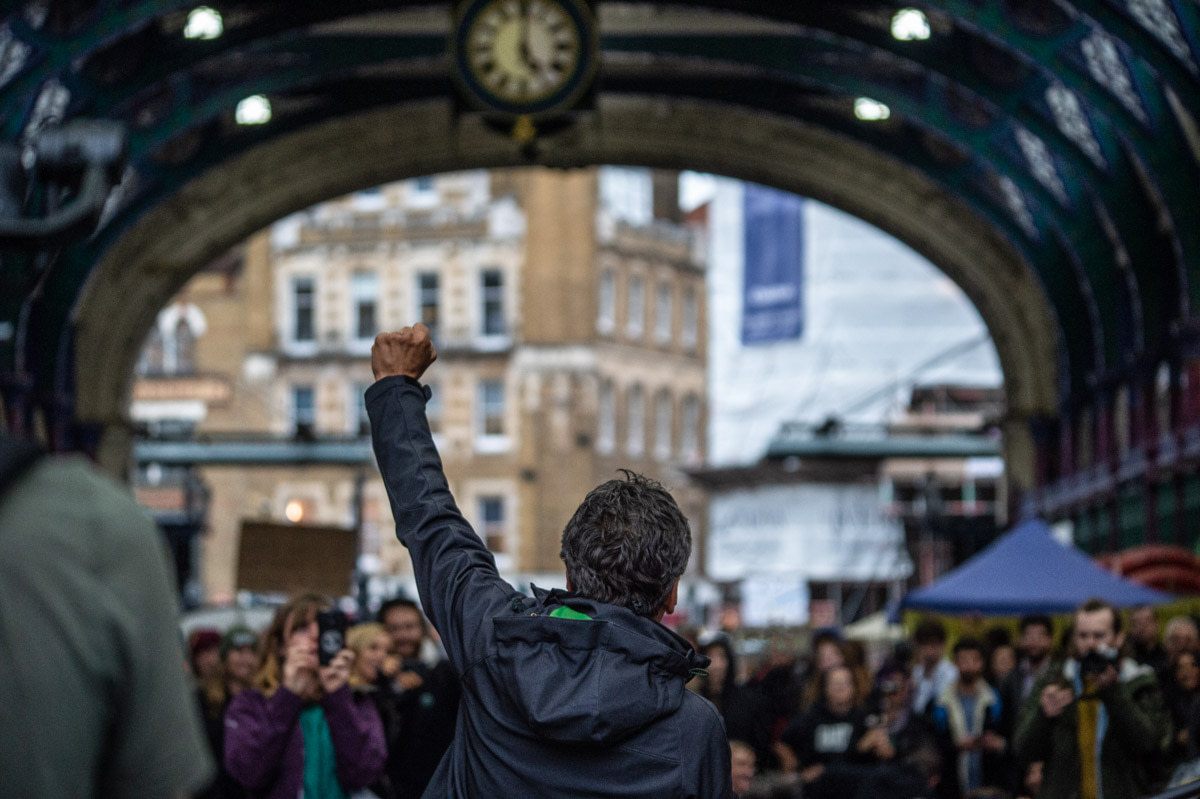George Monbiot delivers an impassioned speech to protesters at the Smithfield meat market takeover. England, 2019.
Jo-Anne McArthur / We Animals
Non-human animals are almost always left out of the equation, be it political, economic, legal, environmental, or scientific. Animal advocates decided they would not be relegated to fringe considerations too.
I recently (October 2019) photographed Extinction Rebellion’s (XR) mass demonstrations against the British government’s inertia with regards to the pressing problems of climate change. As someone invested in documenting the animal advocacy movement, I was particularly interested in the actions of Extinction Rebellion’s sister organization and ally, Animal Rebellion (AR).

Hundreds of AR protesters at a sit-in at DEFRA (Department of Environment, Fisheries, and Rural Affairs).
Jo-Anne McArthur / We Animals

One of many XR camp sites across the downtown London core.
Jo-Anne McArthur / We Animals
AR is an anti-speciesist organization that doesn’t want animals left out of the climate change conversation. We know that industrial farming directly impacts climate change, and we know that billions of sentient beings suffer because of farming. Animal Rebellion argues that to end the climate crisis and achieve justice for animals, we must transition to a plant-based food system. Additionally from AR’s website: Animal agriculture accounts for around 14.5% of all human induced emissions. It uses 83% of global farmland, while only contributing 18% of calories. Almost half of all plastic in the Great Pacific Garbage Patch consists of nets from the fishing industry.
Distilled: AR’s values, goals and demands are here.
Animal Rebellion argues that to end the climate crisis and achieve justice for animals, we must transition to a plant-based food system.

AR protesters take over Smithfield meat market.
Jo-Anne McArthur / We Animals

Thousands of protesters were arrested over the two week Rebellion.
Jo-Anne McArthur / We Animals

Thousands of protesters were arrested over the two week Rebellion.
Jo-Anne McArthur / We Animals
As we’ve seen over centuries, mass demonstration and arrest are a historical form of democratic protest. The tactic is controversial and disruptive. In most cases, that is the point: to jar people out of complacency and initiate discussion and debate. People come together to disrupt when their needs are not being met or their ideas are not being heard. When established pathways to system-wide change have proven unsuccessful, and when governments plainly favour near-term complacency and profit over the harder process of dialogue, negotiation and evolution, the situation becomes untenable for those demanding change. Public protest is often the next step for these engaged and concerned citizens.

Jo-Anne McArthur / We Animals
“The truth is our current governments, businesses and institutions have pretty much failed us on both climate change and animal use. And in doing so, we have massively failed the animals we share the planet with, and the people at the brunt of climate change already, and our generations to come. Urgent action is required, and if governments, businesses, institutions and departments insist on dragging their heels, and effectively dismissing the science especially in relation to ‘livestock’ farming, then we have to expect an escalation of disruption, unrest, protest and the associated negative impacts this brings. If we don’t want to see disruption, we need to see immediate effective action.” — Tim Barford, from Animal Rebellion? Definitely, Maybe.

Political statements through street theatre.
Jo-Anne McArthur / We Animals

Two activists on lock-down.
Jo-Anne McArthur / We Animals
Tens of thousands of people took part in XR and AR protests in London, which has now sparked a continuing global movement. I went in with a tremendous amount of curiosity about the people taking part. What I witnessed was an extremely organized and democratic program for disruption, made up of people trained in how to conduct themselves in peaceful protest.
The camaraderie was visible on every tent- and protest-packed block, and the community ethos was emblematic of the full two weeks. Though XR and AR were born of a profound urgency to be heard on extremely serious matters, a sense of levity buoyed people through the rain, arrests and tear-downs. One protester on lock down – a common term for a protester who has locked, tied, or glued themselves to a place or other person at an agreed-upon location for a pre-meditated action – joked “When are they going to come and arrest me, already? I have an appointment at 3!”

AR activists holding space at DEFRA.
Jo-Anne McArthur / We Animals

Enjoying a laugh with fellow protesters on lockdown.
Jo-Anne McArthur / We Animals

Jo-Anne McArthur / We Animals
Particular to Animal Rebellion, however, was a solemnity around the actions at places of animal exploitation, like at Smithfield, London’s oldest meat market, and at Billingsgate fish market.

Jo-Anne McArthur / We Animals

Jo-Anne McArthur / We Animals
As the procession continued around the market, however, I let the earnest lyrics of their songs permeate, and I felt drawn into this mourning community. A crowded candlelight vigil at a meat market is a thing to behold, photographically, but I found myself moving from outsider to insider; from worried sympathy to entangled empathy. No one would bat an eye to a candlelight vigil for humans or call it an overly sentimental gesture. And it is a really strong gesture. A vulnerable, open-hearted honouring of the suffering and deaths of other species. I came around to deeply appreciating the symbolic and uniting value of the action.
By putting our bodies on the line and risking our liberty, we make this great neglected issue impossible to ignore. — George Monbiot

Jo-Anne McArthur / We Animals

Jo-Anne McArthur / We Animals
Long live the “uncooperative crusties”! (Descriptively coined by British Prime Minister Boris Johnson and gleefully integrated into the protest culture at every opportunity.)
These images offer a glimpse into life and spectacle on the streets during Extinction Rebellion and Animal Rebellion. I’m fascinated and impressed by the people who care enough to show up, organize, take time off work, speak out, and put themselves at the mercy of arrest and derision. Action is the nemesis of inertia, with myriad beautiful branches: momentum, solidarity, catharsis, change.

Jo-Anne McArthur / We Animals
Further Reading
Alex Lockwood, “Beware! Rebellion Really Can Transform Your Life.” AR co-founder and organizer
George Monbiot, The Guardian. “Today, I Aim to Get Arrested”.
Alex Lockwood, trailer to the upcoming film “Monbiot.”
Kristian Buus, The Guardian Photo Essay, “Extinction Rebellion – The Arrestables”
To view more images from this story, please visit our Animal Rebellion Extinction Rebellion gallery on the We Animals Stock Site.


